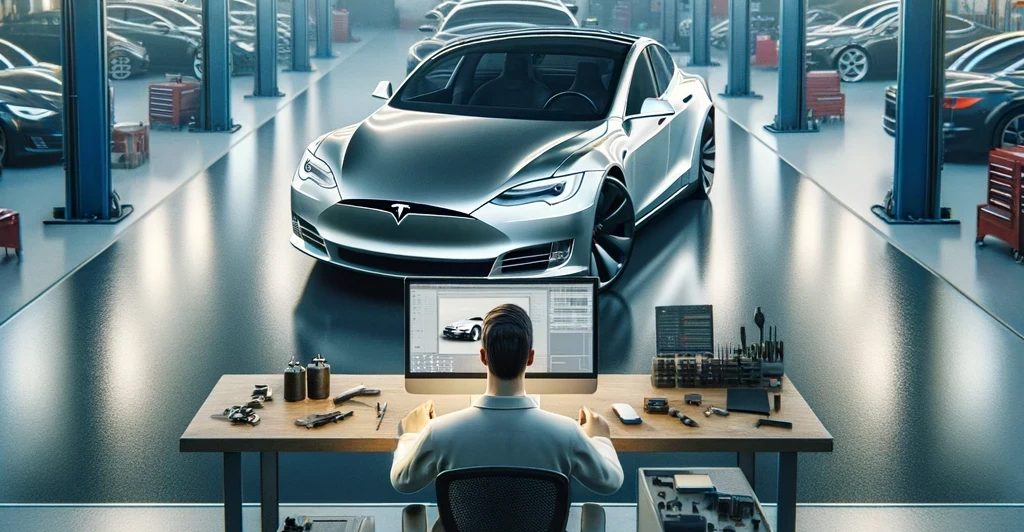AI-enabled inspection technologies can help ensure the transition to an electric future is smooth and sustainable
The transition to widespread adoption of electric and hybrid vehicles (EHVs) necessitates a bridging of the technological divide within the automotive service industry. This divide, marked by a gap between traditional automotive mechanical expertise and the emerging need for electrical and electronic proficiency, is a significant hurdle. Addressing it requires a multifaceted approach, including education, technology access, and a culture of continuous learning among automotive technicians.
Equipping technicians
Educational institutions and training centres play a crucial role in preparing the next generation of automotive technicians. These entities are tasked with developing curricula that encompass the breadth of EHV technologies, from battery management systems to electric motor control. Collaboration with vehicle manufacturers and technology providers can ensure that training programmes remain current with the latest advancements. Moreover, offering modular courses that cater to varying levels of expertise and specialisation can make education in EHV technologies more accessible to a broader audience.
The effective inspection of EHVs hinges on access to advanced diagnostic tools and information. Manufacturers have a pivotal role in ensuring that independent repair shops and inspection stations have the necessary resources to service EHVs. This includes not only physical tools but also access to comprehensive vehicle data and diagnostics software. Establishing standardised data access protocols can help mitigate this challenge, promoting a more transparent and cooperative ecosystem between manufacturers and service providers.
Leveraging data
The integration of artificial intelligence (AI) into vehicle inspection processes represents a transformative leap forward, particularly for EHVs. AI-enabled technologies promise to address many of the inherent challenges in EHV inspection, from diagnostic accuracy to operational efficiency and environmental sustainability.
One of the cornerstone benefits of AI in EHV inspection is its potential to significantly enhance diagnostic precision. Traditional diagnostic methods, often reliant on manual testing and error-prone assessments, can fall short when it comes to the complex electronic systems and software that underpin EHVs. AI, with its ability to process vast amounts of data and learn from patterns, offers a solution. By analysing data from an array of sensors and diagnostic points within the vehicle, AI algorithms can detect anomalies and predict potential failures with a degree of accuracy previously unattainable. This not only improves safety outcomes by preempting issues before they lead to malfunctions but also optimises maintenance schedules, ensuring that vehicles are serviced based on actual need rather than on a predetermined schedule.
Enhanced EHV inspections
The efficiency of vehicle inspections is another area where AI technologies can make a significant impact. AI-driven inspection tools can automate many of the time-consuming tasks associated with vehicle assessments, such as data collection and initial diagnosis. This automation reduces the time vehicles spend in inspection, minimising downtime for owners and operators. Moreover, by standardising the inspection process, AI ensures a consistent level of quality and thoroughness, irrespective of the individual inspector’s expertise or experience.
Effective EHV inspections must consider the entire lifecycle of the vehicle, focusing on long-term sustainability. This includes evaluating the potential for battery repurposing and recycling, as well as the safe disposal of electronic components. Lifecycle assessment during inspection can identify opportunities for extending the useful life of EHV components, contributing to a reduction in electronic waste and the conservation of resources.
The future is now
The adoption of AI-enabled technologies in EHV inspections is not a distant prospect but an unfolding reality. As the automotive industry grapples with the complexities of inspecting and maintaining EHVs, AI offers a suite of solutions that address these challenges head-on. From enhancing diagnostic accuracy and efficiency to promoting sustainability and supporting adaptive regulations, AI-enabled inspection technologies are poised to play a pivotal role in the future of automotive maintenance and safety.
Embracing AI in vehicle inspections requires a collaborative effort across the industry, involving manufacturers, service providers, and regulatory bodies. By investing in AI technology and infrastructure, and fostering an environment of innovation and learning, the automotive sector can ensure that the transition to EHVs is both smooth and sustainable. Looking ahead, the integration of AI into vehicle inspections represents a critical step towards realising the full potential of this next generation of transportation.
The opinions expressed here are those of the author and do not necessarily reflect the positions of Automotive World Ltd.
Jim O’Brien is General Manager of the Americas at RAVIN AI
The AutomotiveWorld.com Comment column is open to automotive industry decision makers and influencers. If you would like to contribute a Comment article, please contact [email protected]
Source: www.automotiveworld.com


